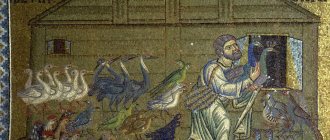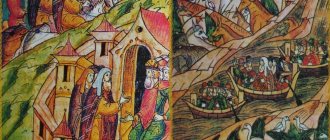And the waters on the earth increased exceedingly,
so that all the high mountains were covered,what are there under the whole sky
(Genesis 7)
Map of ancient Mesopotamia
The Flood is an action similar in scale to the history of creation, but a fulfillment of the opposite sign. Bewilderment immediately arises: two acts with opposite signs, how to evaluate and understand God’s shirking in opposite directions.
“...All the sources of the great deep burst open, and the windows of heaven were opened; and the rain fell on the earth for forty days and forty nights.” “Every creature that was on the surface of [the whole] earth was destroyed; from man to cattle, to creeping things and birds of the air, everything was destroyed from the earth, leaving only Noah and what was with him in the ark. And the waters increased upon the earth for an hundred and fifty days” (Genesis 7).
I will begin my study of the Flood with a statement. Despite the fact that I consider myself an atheist, with the help of this publication I will defend God from theologians and preachers who made him a criminal!
What is the “World Flood”? It is the drowning, the drowning of all living things on the entire Earth, and this act happened by the will of God. Several people chosen by God were saved from the devastating flood - Noah and his wife and with him three sons and their wives.
Let's start with the questions: was the flood “Worldwide” and was the drowning also worldwide?
Scientists have mathematically proven that in order to flood “all the high mountains,” it is necessary to pour out “from the sources of the great abyss” 3 times more water than what is available on earth. Where can I get this quantity? Various options for the origin of water from different sources were investigated. These are: 1) the rise of water from the ground during the eruption of geysers and volcanoes; 2) the arrival of water from space with the help of an icy comet. But neither the first nor the second options work in the history of the Earth.
In the article: “The Mohorovicic Boundary” [2] I already pointed out that the release of steam and water from the mouths of volcanoes and geysers is the release of the same ocean water, so its amount in the cycle does not increase. In addition, with a massive eruption of geysers and volcanoes, a huge amount of poisonous gases would be released, and all living things would die at the very beginning of the flood, including the tribe of Noah.
A collision with an icy comet would also not bring anything comforting. Upon impact, there would have been an explosion of enormous power, after which a high temperature (about 3000 C) would have inevitably risen on the surface of the earth, which again would have turned into a global catastrophe even before the flood occurred.
As for rainwater, “and it rained on the earth for forty days and forty nights,” before the water can be shed, it must first be evaporated. But rainwater is also circular and is clearly not enough for 40 days.
You can look at this problem from a different angle, or rather from the opposite side. Let's say. God found such a quantity of water (he is omnipotent) and spilled it on the earth within 40 days. Then “the waters increased on the earth for one hundred and fifty days.”
At this time, Noah's ark was steadily rocking on the waves. But a new problem would arise: how to get rid of this water? In the Bible this issue is not emphasized or discussed, and the water goes away as if by itself. But nature has its own laws, according to which water cannot simply disappear, it must evaporate. This is actually what happens, under the influence of solar radiation, there is continuous evaporation of water. Since there was no land, evaporation should have increased many times over. From intense evaporation, continuous clouds would form, and new rains would begin. Moreover, it would rain almost constantly - that would be a real flood! Hence the global greenhouse effect! Instead of the planet Earth, we got Venus 2, only with a lower temperature on the surface. It would take tens, hundreds of thousands, and maybe millions of years to evaporate all the water to its current level. I think it’s clear what happened to Noah and his family - he wouldn’t have been able to see the Ararat Mountains. The ark would have been carried along the dune waves until the last creature, no matter whether it was pure or not, was eaten. And then dehydration, and before that there could have been cannibalism. The last one left in the ark was Noah, he is the smartest and God once whispered to him:
God whispered in his ear,
build the ark while the village is dry.
And in this situation, God would be powerless to change anything, because... there was one more problem before the final event.
The creatures got seasick,
They vomited as if in a frenzy.
The air was filled with a stench,
There was a test of surface hell.
Legends of the Flood
In many myths, one plot is often repeated: the gods, angry at people for sinful behavior, send a great disaster upon them - a flood, which leads to the death of all humanity, as well as most of the living nature.
Only the righteous man chosen by the gods, initiated into their plans, gradually prepares for the upcoming trials and, on a boat (ark, box) built in advance, escapes with his family, setting sail across the boundless water surface. Representatives of all species of the animal kingdom are waiting out the disaster with him in the boat. A floating menagerie, after a long search for land, lands on a lonely island, as a rule, at the top of the largest mountain known to a particular people: among the ancient Greeks - Parnassus (in another version - Etna), among the Jews - Ararat, among the Sumerians - Nisir (on east of the Tigris River). Following this, the revival of humanity and wildlife begins. The name of the righteous man chosen by the gods is also different among different peoples: Noah appears in the Bible, Deucalion in the ancient Greek flood myth, Ziusudra or Utnapishtim among the Sumerians, Atra-Hasis among the Babylonians and Assyrians. The flood lasted, according to some versions, seven days and seven nights, according to others - nine days, according to the biblical legend - 40 days and 40 nights. The oldest version of the myth apparently dates back to the beginning of the 3rd millennium BC. e. Later versions date back to the beginning of the 1st millennium BC. e.
The question arises: was there one legend that wandered from one people to another, or was there really something similar to a flood in their history that was passed down from generation to generation? It is quite obvious that the most dramatic events are stored in people's memory, which are gradually transformed into myths and tales with their characteristic exaggerations and implausible details. Of course, in the history of every nation there have been periods of very unfavorable weather conditions: prolonged downpours or hurricanes of unprecedented strength, followed by floods and mudslides that brought death to people and animals. Often the losses were so great that there were even displacements of large masses of people who left their homes forever. In this sense, the legend of the flood could have been born among any people.
However, those variants that existed among the ancient population of Southern Europe and Western Asia coincide not only in plot, but also in the most important details, which is difficult to explain by the multifocal origin of this legend. After all, even floods are caused by different reasons and occur in different ways. Therefore, it is likely that the myth of the Flood still comes from one, ancient source and reflects some true event - a cataclysm that rarely occurs in nature. Already born, this myth spread over time among the peoples who lived near the centers of its origin.
This means that we can conclude that memories of a real flood, in other words, a terrible flood, most likely come from the Sumerians - the oldest of the peoples of Mesopotamia - who created one of the first civilizations in the lower reaches of the valleys of the Tigris and Euphrates rivers. From the Sumerians, this legend passed on to the Babylonians and Assyrians, who successively replaced each other in this region, and from them to the Semitic tribes who moved in the 18th–17th centuries. BC e. from Mesopotamia to Canaan (Palestine). Apparently, later the Hittites and Phoenicians told this legend to the inhabitants of Crete, and from them it reached the ancient Greeks.
The answer to the question of why the Sumerians had a legend about the global flood was given by excavations at the site of one of the oldest cities in the world - Ur, located on the banks of the Euphrates. In a deep pit, 14 m from the surface, under the tombs of the Sumerian rulers who lived at the beginning of the 3rd millennium BC. BC, the English archaeologist L. Woolley discovered a thick horizon of silty sediments, devoid of traces of human culture. It seemed that there was no point in digging further, since the pit revealed the base of the anthropogenic strata. However, L. Woolley ordered the pit to be deepened and was rewarded for this. Having passed through a 3-meter layer of silt, the pit again entered sediments, which contained fragments of bricks and ceramics. These finds belonged to a completely different culture, a different people, who probably died as a result of a natural disaster - a flood that flooded large areas in Mesopotamia.
Indeed, later calculations indicate that the water level that deposited a 3-meter layer of silt was at least 8 m higher than the level at which the ancient settlement was located, destroyed by the elements. It is not surprising that to the few people who survived such a catastrophe, the flood might seem worldwide. Subsequently, the story of eyewitnesses, transmitted to the new nomads who came to these places (and they were the Sumerians), acquired incredible details and interpretations of the priests. With their help, he was transformed into a legend about how the gods destroyed the first people for their innumerable sins, preserving only the family of the righteous for the future.
The conclusion that the Old Veil contains a version of an older Sumerian legend was made even before the excavations in Ur by an employee of the British Museum, J. Smith. He read it on baked clay tablets that were brought from another Sumerian city - Nineveh. The story of the flood was written on them in cuneiform - the oldest type of writing deciphered by this scientist. The hero of the Sumerian epic Gilgamesh meets during his wanderings an eyewitness to the stream Utnapishtim, whose story about his experiences is then given in the first person.
What caused the flood that led to the death of the earliest civilization in the lower reaches of the Tigris and Euphrates? This could have been a major flood, associated either with the melting of an unprecedented amount of snow in the mountains of the Eastern Taurus, or with prolonged rainfall in the arid valleys. However, it is difficult to imagine that even the most severe flood could lead to the death of the entire population. Floods do not immediately reach their maximum, and, therefore, observing a gradual increase in the river level, the ancient inhabitants could leave those places. In a few days, during which, according to legend, the rains raged, people would have managed to reach elevated plateaus or foothills that were never completely flooded with water. And no matter how strong the flood was, it would hardly be able to deposit a 3-meter layer of silt. Such an amount of displaced material indicates a genuine catastrophe that occurred quite suddenly and was associated with an extraordinary event.
This could well have been a strong earthquake in the Taurus Mountains, which led to the destruction of a natural dam that once blocked the exit from the gorge, where there was a large mountain lake. An equally enormous earthquake in the Zagros Mountains or in the Strait of Hormuz could cause a sharp displacement of sections of the bottom along faults in the Persian Gulf or the Arabian Sea and generate a giant wave that hit the coast. But Ur was located on the coast of the Persian Gulf, since during the period of the Flemish transgression the coastline was located inland, some tens of kilometers from the modern one.
And in. In both cases, the water had to carry a huge amount of turbid silty sediment. However, if the disaster happened in the mountains of the Eastern Taurus, then it would inevitably give rise to a powerful mudflow, which, together with thin clay material, would carry a large number of different-sized rock fragments to the plain. If the disaster was caused by a tsunami, that is, it came from the sea, the clayey silt and sand lining the bottom in this part of the Persian Gulf should have been washed out in the river deltas. A thorough study of the sediment that makes up the silt horizon not only in the excavated part of the ancient city of Ur, but also in neighboring areas of the alluvial valley of the Euphrates River should answer the question of what kind of geological catastrophe occurred in Mesopotamia approximately 5 thousand years ago. According to the descriptions of L. Woolley, this sediment does not contain large rock fragments. Namely, they, rolling down from the mountains with water and silt, should have covered the ancient settlements in the Euphrates valley.
Another evidence in favor of the tsunami can be the fact of the death at about the same time of another ancient civilization - Mohenjo-Daro, which existed in the lower reaches of the Indus River in the northwestern part of the Hindustan Peninsula, i.e. on the other edge of the Arabian Sea. Now, in the absence of precise dating of the sediments covering the ruins of Ur and Mohenjo-Daro, it is difficult to judge how connected these two catastrophes are. It is obvious, however, that the tsunami, having originated somewhere in the Strait of Hormuz or in another part of the Arabian Sea, could maintain its destructive power, passing the entire Persian Gulf and reaching Mesopotamia on one side, and the Indus Delta on the other.
An example of a catastrophe caused by a giant tidal wave invading a river delta is the events that occurred in our memory in the lower reaches of the Ganges and Brahmaputra. The hurricane, which raged for several days in the Bay of Bengal in the fall of 1969, was accompanied by winds whose speed exceeded 200–250 km/h. It gave birth to a tornado, which swept over the delta on the night of November 12-13, uprooting trees and destroying homes. Then, as eyewitnesses testify, an ominous rumble came from the ocean, growing stronger every minute. Soon powerful waves hit the islands and banks of river channels. For some time there was a deceptive silence, when it seemed that the elements were subsiding. And then a terrible wave poured in. The water flooded not only houses, but also the treetops on which desperate people were fleeing. This came a wave, 10 m high. It swept across an area of tens of thousands of square kilometers, flooding all the islands and part of the land adjacent to the delta. Several hundred thousand people died (according to various sources, from 150 to 350 thousand).
This is what kind of trouble a tidal surge generated by a hurricane can cause, and what destructive potential a tide caused by a catastrophic tsunami should have, if we remember that wave heights can reach 40 m.
>Myth of the Flood
1 1 1 1 1 Rating 4.34 Details Category: Myths of Ancient Greece
Number of people of the antediluvian period
The Bible indicates that 10 generations passed before the catastrophic flood. This figure also includes the first couple Adam and Eve, who gave birth to three sons Cain, Abel and Seth. After the flood, King Noah also gave birth to three sons. Therefore, for a relative assessment, let’s take that each generation increased the number of its descendants three times. For the calculation, we take the equation of a geometric progression, any term of which can be calculated using the formula.
an=a1q n-1
a1 – first term; q – progression denominator; n – number of the taken member.
Taking into account the errors, Cain killed Abel and Abel did not give birth to offspring, but in some families there were more than 6 children (more than three boys), let's take the average denominator of the progression equal to three. We also set the first term equal to 3.
The calculation gives the following figures; we take the last three generations, assuming that the previous generations had died by that time.
a8 =6561; a9=19683; a10=59049 (number of hereditary men in the last three generations). Adding these numbers and multiplying by two (the number of women), we get the approximate number of inhabitants of the earth for that period.
S=170586 people.
The figure of 170 and a half thousand people may well be adequate (±10%), despite the fact that many children were born, but many died before reaching childbearing age.
As you can see, the number of people living on the planet is tiny. What I mean is that God (the aggregate of the mind) will not do something without meaning, so as not to redo anything in the future. He tried so hard to create the first pair of intelligent people in the image and likeness of himself, not in order to actually drown them right there, but so that they would multiply, fill the Earth and rule it. Moreover, some 10 generations passed, the planet was free. And what kind of people they are: all of them are chosen – God-pleasing. Judge for yourself, drown them as unwanted kittens?
No! God couldn't do that! That's why there was no Flood.
If you drown people on the principle “that the wickedness of men is great in the earth, and that every intent of the thoughts of their hearts is evil continually (Genesis 6)”, for virtually no reason, then this should have been done at the beginning of the 20th century, before the destructive two world wars. Or bring this flood at the present time, when terrorism and religious fanaticism are rampant. When one religion hates another, although God is one for all. When huge arsenals of deadly nuclear weapons have been accumulated, which at any moment can destroy the Earth, and with it God himself. If this does not even affect his “physical” or “spiritual” appearance, it will affect his status: who will he control? Bacteria or certain types of fish preserved in the ocean, or some other creatures? But he will not wait for the altar from them!
But God is silent and does nothing, and the situation on the planet is getting worse every year, not only because of the bad deeds of its inhabitants, but also because of the very rapid overpopulation.
What is the conclusion? And the conclusion is this: either God has lost his power, or there is no God! In the previous article it was noted (during the cloning of Eve) that God had senile sclerosis, because he forgot that the first woman had already been created by him, but he forgot about it. After the flood, God also did not show any active actions, except that he added several more religions, and thus further divided the peoples. Perhaps by this time God had lost control or he had passed away. Although no such information was reported in the media. But how could she do it when there are no correspondents around him (all correspondents are in the hot spots of the planet), or any means of communication.
Not divine mistakes
In the book by J. E. Smith “The Pentateuch” [5] (a relevant commentary for the modern reader, p. 70) it is stated, quote: “It is impossible to determine the age of Cain and Abel when this murder occurred. Cain's phrase suggests that he was much older than generally believed. By the time Cain was 400 years old, the world's population could well have reached 100,000."
The author does not disclose where such a number of people suddenly came from. I could ignore this absurdity, but some sources provide simply fantastic figures for the number of people of the antediluvian period. Quote: “It can, however, be argued that the population of the Earth was quite large. Thus, many centuries before the Flood, Cain, the son of Adam, had already built a city (Genesis 4:17). It is clear that by the time of the Flood there were many such cities on earth” [6].
If Cain built a “city”, then people should live in the city, isn’t that ironclad logic? The same source gives a general figure: “the number of just the last generation before the Flood could have reached more than 500 million people.”
What a “huge” city - one family of 3 people!
In the source [7], the number of inhabitants of the earth of the antediluvian period increased to 870 million! And this is not the limit, Archpriest V. Tulupov in his lecture mentions the figure - 3 billion people [8].
To everything quoted, I can only add: this is how myths and legends are born today by enlightened people, and we catch, excuse me, “fleas” in the antediluvian period. We cling to every word, phrase, every number, as if it were the ultimate truth. I just want to wish: let’s not be naive.
With regards to the source [5 interpreter of the Pentateuch], how could 100 thousand people appear when Cain was the first child born from the first couple Adam and Eve? Obviously, the author assumed that Cain gave birth to this army of people, along with his parents. But let's be at least a little realistic, if we consider that the usual representation of simultaneously living people is equal to three generations, then to achieve the figure of 100 thousand, each family in a generation must produce offspring of at least 74 children! And taking into account those who died at an early age, even more. As you can see, the numbers are absolutely not real. People are not rabbits.
Abel, as we know, left no offspring, and Seth, the younger brother, was not yet born. At the same time, the Bible clearly states that Cain became a parent after the murder of his brother. From Adam to Noah, through the generation of Seth, only 10 generations passed.
Now let's return to the figure of 400 years, where it came from is also not clear. In the article: “How old is Adam” [9], I proved that the life span of the first people was the same as that of our generation. How long Cain lived is not indicated in the Bible, but the age of his younger brother is given: “All the days of Seth were 912 years; and he died." Divide the years of Seth by the correction factor of 12.35 and get 73.8 years.
From the brothers came two tribes: Cainites and Sethites. Cainites were engaged in crafts, art, and culture. The Sethites adhered to an ascetic direction in life. God chose the heir of Seth, the subsequent generation of Noah and his tribe. Why? The answer is at the end of the article.
But where do theologians get such numbers of people who lived in the antediluvian period? The more they collect, the more God is at fault. Theologians cut off the branch on which they sit!
Another confusion, only this time, not in the Bible, but in the heads of those reading the Bible. Confusion of the biblical text with the Assyrian legend. Look at the map of ancient Mesopotamia (3000 - 1600 BC), how many cities are there. Before the Mesopotamian flood, a substantial population lived in the interfluve, and most of the remains of these people rest on the bottom of the Persian Gulf. But we examine the text of the Bible, which clearly states that there were 10 generations before the flood. Accordingly, the calculation gives a figure of about 170 thousand people. Let us be consistent; we read the texts of the Bible and the Chaldean Epistle separately. God did not participate in the Mesopotamian flood; there nature itself decided the destinies of people.
But enough about the numbers, how is the main character doing and where is his ark? Read on...
Back forward
Flood myth (ancient Greek myth)
Immortal gods live forever on Olympus, and time has no power over them. And below, on earth, people are born and die, generations change, one century comes to replace another. The Golden Age gave way to the Silver Age, then came the Copper Age. The people of the Copper Age were cruel and powerful, and they committed many crimes. Then the great Zeus decided to destroy life on earth in order to later revive new people, better than the old ones. But it was not so easy for him to decide on such a thing. And he wanted to test people again. He descended to earth and, disguised as a mere mortal, came to Arcadia to the city of Lykosura, where the rude and arrogant king Lykaon ruled. As always, on this hot sunny day, a lot of people gathered in the city square, and it seemed that the tall, gray-bearded old man did not stand out among the rest of the mortals. But then he raised his hand, his sharp, piercing eyes emitted such an extraordinary light that no one even doubted: in front of them was the great Thunderer himself. Some fell to their knees in front of the majestic old man, others bowed their heads in respect. There were also servants in the square
King Lycaon. They hurried to the palace to inform the king about this great event. But Lycaon began to mock the gullible people: “Where did you see God and who told you that this old robber is a god?” – he asked his servants mockingly. – Are there a lot of crooks walking around the city? Then he figured out how to insult the gray-haired old man even more, and at the same time check to see if maybe people were telling the truth. The king ordered the murder of a hostage who lived in his house, and prepared food from the body of the murdered man. Then he went out to the square and invited Zeus to come to his palace to taste the treat. The great Zeus became terribly angry, he waved his club, and bright lightning flew out of it. In the blink of an eye, Lycaon's palace collapsed, and he himself turned into a bloodthirsty wolf. After this, the great Zeus returned to Olympus. He did not then destroy the human race, because along with the bad people the good ones could die. But time passed, and the number of wicked people increased. It has already happened that before they had time to be born and grow up, they began to fight and kill each other. Zeus thought for a long time, and finally he decided to send a terrible punishment on people - to destroy them under water. And immediately all the winds stopped blowing, except for the southern - humid Not. Noth flew over the sinful earth on his wet wings, his terrifying face peeks out from behind the black fogs, his shaggy beard is heavy with moisture, powerful streams flow through his gray hair, gray clouds sit on his forehead. Noth squeezed the hanging clouds with his powerful hand, a terrible crash split the sky, and the rains locked in the sky poured out. The river gods prayed to Zeus. The water has filled the rivers and there is no longer any strength to hold it back. But the great thunderer is inexorable. He ordered to remove all barriers, remove the banks and release the streams to freedom. He himself struck the ground with his trident and opened the way for all the waters. Mighty streams flowed freely across the earth, carrying with them everything that was on it. And it is no longer possible to distinguish where the land is and where the sea is. Where horned goats recently nibbled green grass, well-fed seals are located, dolphins swim in the forests, wolves swim through the water between sheep and do not touch them, mighty waves drag a red lion, and nearby the branchy antlers of a deer stick out of the water. Tired birds fly in the sky with a plaintive cry and cannot find anywhere to sit down to rest. The Great Flood buried under water all life that was on earth, and with it the Copper Age ended.
- END -









